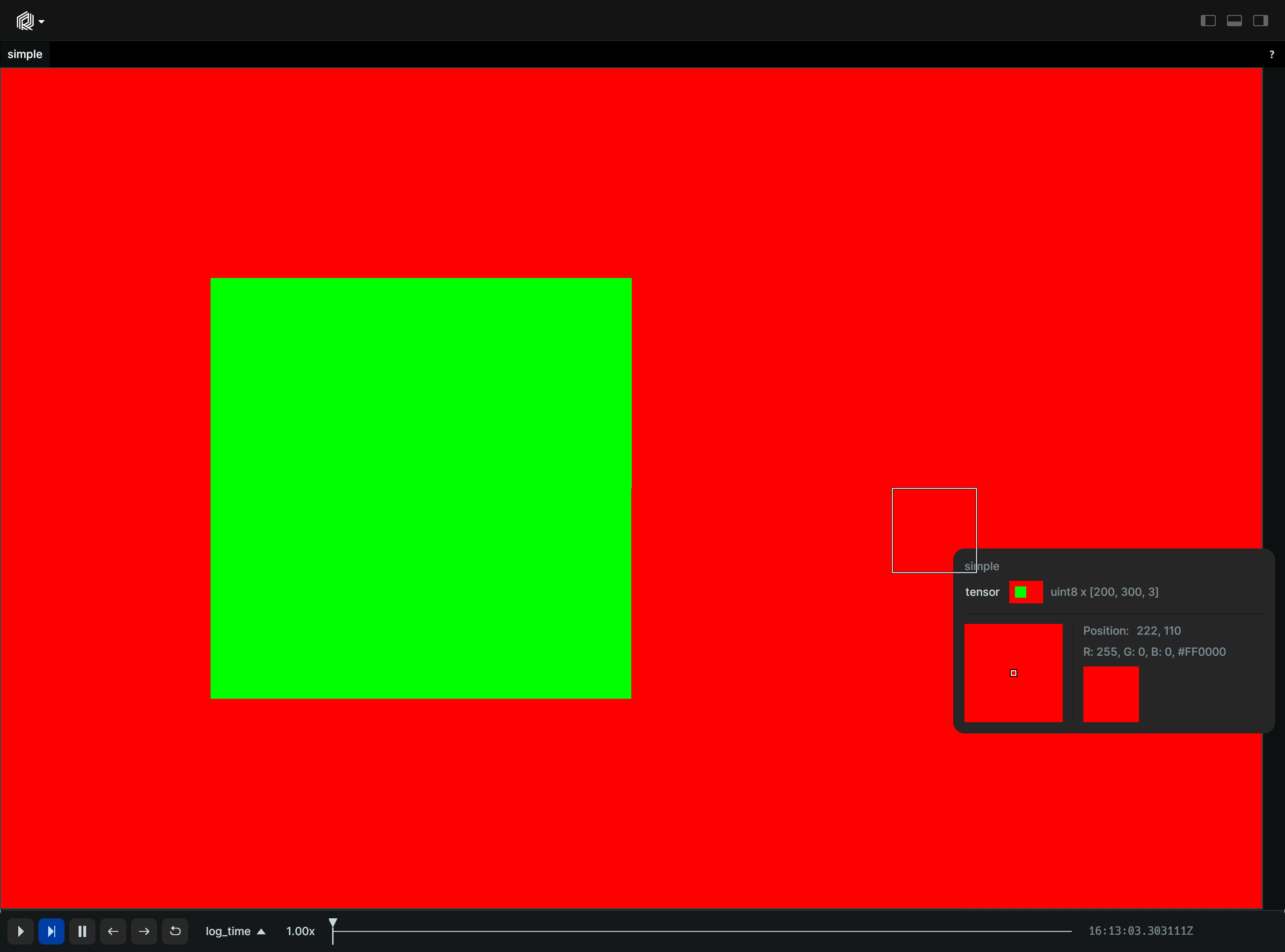Image
A monochrome or color image.
See also archetypes.DepthImage and archetypes.SegmentationImage.
Rerun also supports compressed images (JPEG, PNG, …), using archetypes.EncodedImage.
For images that refer to video frames see archetypes.VideoFrameReference.
Compressing images or using video data instead can save a lot of bandwidth and memory.
The raw image data is stored as a single buffer of bytes in a components.Blob.
The meaning of these bytes is determined by the components.ImageFormat which specifies the resolution
and the pixel format (e.g. RGB, RGBA, …).
The order of dimensions in the underlying components.Blob follows the typical
row-major, interleaved-pixel image format.
Components components
Required: ImageBuffer, ImageFormat
Shown in shown-in
- Spatial2DView
- Spatial3DView (if logged under a projection)
- DataframeView
API reference links api-reference-links
Examples examples
image_simple imagesimple
"""Create and log an image."""
import numpy as np
import rerun as rr
# Create an image with numpy
image = np.zeros((200, 300, 3), dtype=np.uint8)
image[:, :, 0] = 255
image[50:150, 50:150] = (0, 255, 0)
rr.init("rerun_example_image", spawn=True)
rr.log("image", rr.Image(image))
Logging images with various formats logging-images-with-various-formats
"""Create and log an image with various formats."""
import numpy as np
import rerun as rr
rr.init("rerun_example_image_formats", spawn=True)
# Simple gradient image, logged in different formats.
image = np.array([[[x, min(255, x + y), y] for x in range(0, 256)] for y in range(0, 256)], dtype=np.uint8)
rr.log("image_rgb", rr.Image(image))
rr.log("image_green_only", rr.Image(image[:, :, 1], color_model="l")) # Luminance only
rr.log("image_bgr", rr.Image(image[:, :, ::-1], color_model="bgr")) # BGR
# New image with Separate Y/U/V planes with 4:2:2 chroma downsampling
y = bytes([128 for y in range(0, 256) for x in range(0, 256)])
u = bytes([x * 2 for y in range(0, 256) for x in range(0, 128)]) # Half horizontal resolution for chroma.
v = bytes([y for y in range(0, 256) for x in range(0, 128)])
rr.log("image_yuv422", rr.Image(bytes=y + u + v, width=256, height=256, pixel_format=rr.PixelFormat.Y_U_V16_FullRange))
Image from file, PIL & OpenCV image-from-file-pil--opencv
"""Log an image."""
import tempfile
import cv2
import numpy as np
import rerun as rr
from PIL import Image as PILImage, ImageDraw
# Save a transparent PNG to a temporary file.
_, file_path = tempfile.mkstemp(suffix=".png")
image = PILImage.new("RGBA", (300, 200), color=(0, 0, 0, 0))
draw = ImageDraw.Draw(image)
draw.rectangle((0, 0, 300, 200), outline=(255, 0, 0), width=6)
draw.rounded_rectangle((50, 50, 150, 150), fill=(0, 255, 0), radius=20)
image.save(file_path)
rr.init("rerun_example_image_advanced", spawn=True)
# Log the image from the file.
rr.log("from_file", rr.EncodedImage(path=file_path))
# Read with Pillow and NumPy, and log the image.
image = np.array(PILImage.open(file_path))
rr.log("from_pillow_rgba", rr.Image(image))
# Drop the alpha channel from the image.
image_rgb = image[..., :3]
rr.log("from_pillow_rgb", rr.Image(image_rgb))
# Read with OpenCV.
image = cv2.imread(file_path)
# OpenCV uses BGR ordering, we need to make this known to Rerun.
rr.log("from_opencv", rr.Image(image, color_model="BGR"))
Update an image over time update-an-image-over-time
"""
Update an image over time.
See also the `image_column_updates` example, which achieves the same thing in a single operation.
"""
import numpy as np
import rerun as rr
rr.init("rerun_example_image_row_updates", spawn=True)
for t in range(20):
rr.set_time_sequence("time", t)
image = np.zeros((200, 300, 3), dtype=np.uint8)
image[:, :, 2] = 255
image[50:150, (t * 10) : (t * 10 + 100)] = (0, 255, 255)
rr.log("image", rr.Image(image))
Update an image over time, in a single operation update-an-image-over-time-in-a-single-operation
"""
Update an image over time, in a single operation.
This is semantically equivalent to the `image_row_updates` example, albeit much faster.
"""
import numpy as np
import rerun as rr
rr.init("rerun_example_image_column_updates", spawn=True)
# Timeline on which the images are distributed.
times = np.arange(0, 20)
# Create a batch of images with a moving rectangle.
width, height = 300, 200
images = np.zeros((len(times), height, width, 3), dtype=np.uint8)
images[:, :, :, 2] = 255
for t in times:
images[t, 50:150, (t * 10) : (t * 10 + 100), 1] = 255
# Log the ImageFormat and indicator once, as static.
format = rr.components.ImageFormat(width=width, height=height, color_model="RGB", channel_datatype="U8")
rr.log("images", rr.Image.from_fields(format=format), static=True)
# Send all images at once.
rr.send_columns(
"images",
indexes=[rr.TimeSequenceColumn("step", times)],
# Reshape the images so `Image` can tell that this is several blobs.
#
# Note that the `Image` consumes arrays of bytes, so we should ensure that we take a
# uint8 view of it. This way, this also works when working with datatypes other than `U8`.
columns=rr.Image.columns(buffer=images.view(np.uint8).reshape(len(times), -1)),
)



